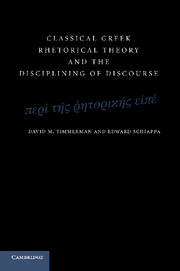Book contents
- Frontmatter
- Contents
- Acknowledgments
- 1 INTRODUCTION: Terms of Art as a Focus in the History of Rhetorical Theory
- 2 DIALEGESTHAI AS A TERM OF ART: Plato and the Disciplining of Dialectic
- 3 PHILOSOPHIA AS A TERM OF ART: Recovering Isocrates
- 4 TERMS OF ART FOR PUBLIC DELIBERATION: Dēmēgoria and Symboulē
- 5 TERMS OF ART AND THE INTERPRETATION OF TEXTS: The Disciplinary Status of the Rhetoric to Alexander
- 6 TERMS OF ART AND INFERRING THEORY: When Did the Parts of a Speech Become Formalized?
- 7 EPILOGUE
- References
- Index
5 - TERMS OF ART AND THE INTERPRETATION OF TEXTS: The Disciplinary Status of the Rhetoric to Alexander
Published online by Cambridge University Press: 06 July 2010
- Frontmatter
- Contents
- Acknowledgments
- 1 INTRODUCTION: Terms of Art as a Focus in the History of Rhetorical Theory
- 2 DIALEGESTHAI AS A TERM OF ART: Plato and the Disciplining of Dialectic
- 3 PHILOSOPHIA AS A TERM OF ART: Recovering Isocrates
- 4 TERMS OF ART FOR PUBLIC DELIBERATION: Dēmēgoria and Symboulē
- 5 TERMS OF ART AND THE INTERPRETATION OF TEXTS: The Disciplinary Status of the Rhetoric to Alexander
- 6 TERMS OF ART AND INFERRING THEORY: When Did the Parts of a Speech Become Formalized?
- 7 EPILOGUE
- References
- Index
Summary
The rhetoric toAlexander is a curious text. The author? Controversial. The date of composition? Uncertain. Its purpose? Traditionally regarded as a handbook of rhetoric, the term rhētorikē does not appear except in an obviously forged prefatory letter. Although the text seems intended as a teaching aid to aspiring public advocates, the disciplinary status of pedagogical practices for the teaching of logos in the fourth century bce is a matter of some contention.
Kennedy (1999) argues that there are three strands of classical rhetorical theory that can be dated back to the fifth and fourth centuries bce: technical, sophistic, and philosophical rhetoric. Although Kennedy's schematization is problematic when applied to the fifth century (Schiappa 1999), it remains generally accepted (Mirhady 2007, 3). Most scholars would agree that, by the mid-fourth century, Aristotle's Rhetoric represented one approach to rhetoric and Isocrates' logōn technē another, and that historically these two approaches are often dubbed (fairly or not) philosophical versus sophistic. According to Aristotle's account, there was also a strong technical tradition at this time represented by assorted rhetorical technai, although none of these survive – with the possible exception of the Rhetoric to Alexander itself.
But where does the Rhetoric to Alexander fit in? We suggest that it is possible to classify the Rhetoric to Alexander in relevant respects as Aristotelian, sophistic, and technical, although a superior interpretive strategy might be to abandon such nomenclature altogether.
- Type
- Chapter
- Information
- Publisher: Cambridge University PressPrint publication year: 2010



